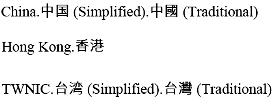Introduction
As noted in our FocusPaper 'Domain Name System Revolution Part 1: Generic Top Level Domain Names' published 1 November 2010,1 the implementation of Internationalised Domain Name country code Top Level Domains (IDN ccTLDs) which commenced this year is the second tranche of the revolutionary changes currently being made to the domain name system.
In conjunction with the new generic Top Level Domain (gTLD) program, which will soon allow companies and organisations to apply for and operate their own personalised gTLDs containing their brand or product name, for example .addisons or .law, the implementation of IDN ccTLDS throughout the world will enable companies and organisations to register entire domains in non-English language scripts for the first time in history.
Understanding this further expansion of the domain name system is important for companies and organisations wanting to reach non-English speaking countries online and for those wishing to foster already established presences in non-English speaking countries. The IDN ccTLD program will lead to the registration of domain names never before possible, which companies and organisations will use to market their brands online. Companies and organisations seeking to prevent others from registering their trade mark as part of a domain in a different language script may also seek to register internationalised domain names (IDNs) with IDN ccTLDs as precautionary or protective measures to ensure the protection of their intellectual property interests into the future.
Background
60% of Internet users are from a non-English background. Until now, Internet users who write in languages other than English have had to insert Latin alphabet characters as the end top level domain country code suffix to the domain name entered in their browser.
From mid 2010, government authorities (or their designated representatives) around the globe have been applying to ICANN (the Internet Corporation for Assigned Names and Numbers) via the IDN ccTLD Fast Track Process to obtain top level country code top level domains in their own national language scripts.
The IDN ccTLD Fast Track Process allows countries which use non-Latin based languages to request top level domains reflecting the top level domain name of their country in their local scripts, which, in turn, then allows domain name registries of these countries granted a new IDN ccTLD to offer out to Internet users previously unavailable domain names to be registered in that local script.
The first IDN ccTLDs to go live on the Internet were designated in the Arabic alphabet script. To date, 22 countries or territories have been successful in their IDN ccTLD applications, with the first four completely non-Latin top level domains (TLDs) going live in May 2010 for the United Arab Emirates, Saudi Arabia, Egypt and Russia. Currently, 12 countries/territories (represented by 15 IDN ccTLDs) are live online. A list of the countries which have completed the Fast Track Process is available on the ICANN site, along with a list demonstrating what each IDN ccTLD will look like is available at http://www.icann.org/en/topics/idn/fast-track/string-evaluation-completion-t-en.htm
Why implement IDN ccTLDs?
Before IDNs with IDN ccTLDs were available, country codes in domain names were represented only in Latin alphabet characters. Before 2003, there were no domain names with non-Latin language scripts in existence at all. The reach of the Internet has now led to different language scripts being used in domain names, which has had the effect of:
- Strengthening and promoting multilingualism in cyberspace;
- Reflecting the geographic expansion of the Internet;
- Reflecting the corresponding increase of use by various linguistic groups or communities, leading to domain names consisting of characters from all scripts used in the world today;
- Making the ccTLD string easy to understand for those who use different languages, especially those who use the script of the string in their browser on keyboards with non-English keys; and
- Opening up accessibility of the Internet around the world.
Before now, where, for example, the content of a website was in a local language other than English, the local language script could not extend to the top level country code of the domain name. This is now in a state of change as a result of the new IDN ccTLD program. Consider, for example, reading an online newspaper in Beijing, China. If there is a link to further information, it makes sense that that link is represented in a website address that is not only a legible symbol, but is also a meaningful expression of the link.
By way of example, Chinese IDN ccTLDs will soon be delegated into the root of the domain name system as follows:

Further IDN ccTLDs which have passed the String Evaluation Phase this year are:

Trade Mark Issues with IDNs with IDN ccTLDs
Before each applicant country's IDN ccTLD is rolled out, trade mark owners are generally being provided with the opportunity to submit priority applications for domain containing their trade mark (which ends in the particular country's designated IDN ccTLD).( names ) During the relevant sunrise period, trade mark holders and brand owners can register domain names containing their marks. Sunrise periods are being held to enable trade mark owners the opportunity to protect their rights in the new IDN top level domain space. Following the relevant sunrise period, in some countries, the country's responsible domain name registry will then operate a land rush period to allow for the registration of high-demand generic domain names within the particular IDN ccTLD suffix domain name space.
By way of example as to the take up of these new domains, the new Russian IDN .РФ had 18,000 "sunrise" registrations, and during its "land rush" period received 36,607 new domain registrations during the first hour and over 100,000 new registrations within the first 3 hours of the land rush opening. It is hoped that rolling out IDNs with IDN ccTLD with an initial sunrise period open for a specific period of time will assist in combating cyber-squatting. There are rules specific to each country with respect to reserving a domain name within a relevant sunrise period, depending on the controlling registry of that particular country. Typically, to reserve a domain name during a designated sunrise period under a newly proposed IDN ccTLD, applicants with registered trade marks may apply only for domain names that match exactly with the trade mark registered with the corresponding trade mark registry in the relevant country.
Companies and organisations with trade marks which are not registered or are at application stage are not generally being permitted to reserve domain names within a sunrise period for the particular country.
How can you register for an IDN with an IDN ccTLD?
Registering an IDN with an IDN ccTLD may be important to your company or ogranisation for reaching non-English speaking markets. Currently, a number of non-English language speaking nations around the globe are either progressing through or are implementing the IDN ccTLD process with ICANN for their country Each registry will implement its own timeframes for sun rise periods. Eligible trade mark holders need to keep aware of these sun rise period time frames around the world for particular countries in which they have an interest.
Challenges
Alongside the potential to increase marketing methods to reach new and emerging markets, the risk that cyber squatters will register your trade mark or brand name with an IDN likewise increases, particularly where your company or organisation has not participated in the relevant sun rise period which corresponds to your trade mark registration. It is therefore important that trade mark holders are vigilant and up to date when navigating the new IDN ccTLD terrain. In addition, trade mark holders should consider whether defensive registrations are necessary, especially in particular non-English speaking markets which may have important strategic value for their products or services in the future.
Another noteworthy challenge for trade mark holders is that smaller countries which do not attract as much publicity as larger countries are also releasing IDN ccTLDs. These counties' sunrise periods, if a trade mark holder is not careful, could easily be overlooked, and IDN opportunities which may be available in those countries could be missed, as opportunities abound in these smaller markets as well as larger ones.
Conclusion
To recap, registering an IDN with an IDN ccTLD may provide your company or organisation with increased marketing opportunities in different countries. Protecting your trade mark abroad by being aware of any relevant sunrise period for which your trade mark may be eligible and registering domain names containing your trade mark before anyone else has this ability is also a step towards protecting your valuable intellectual property assets throughout the world.
Our intellectual property team at Addisons can provide advice and strategy concerning the procedures involved in both registering and opposing IDN applications as this new IDN process continues to evolve around the world. Please do not hesitate to contact any member of the Addisons' IP team for any further information or assistance.
The assistance of Mandy Chapman, Solicitor, and Rahil Patel, Clerk, of Addisons in the preparation of this article is noted and greatly appreciated.
1. http://www.addisonslawyers.com.au/focuspaper/179
The content of this article is intended to provide a general guide to the subject matter. Specialist advice should be sought about your specific circumstances.

